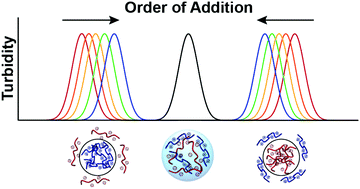The benefit of poor mixing: kinetics of coacervation†
Abstract
Complex coacervation has become a prominent area of research in the fields of food science, personal care, drug stabilization, and more. However, little has been reported on the kinetics of assembly of coacervation itself. Here, we describe a simple, low-cost way of looking at the kinetics of coacervation by creating poorly mixed samples. In particular, we examine how polymer chain length, the patterning and symmetry of charges on the oppositely charged polyelectrolytes, and the presence of salt and a zwitterionic buffer affect the kinetics of complex coacervation. Our results suggest an interesting relationship between the time for equilibration and the order of addition of polymers with asymmetric patterns of charge. Furthermore, we demonstrated that increasing polymer chain length resulted in a non-monotonic trend in the sample equilibration times as a result of opposing factors such as excluded volume and diffusion. We also observed differences in the rate of sample equilibration based on the presence of a neutral, zwitterionic buffer, as well as the presence and identity of added salt, consistent with previous reports of salt-specific effects on the rheology of complex coacervates. While not a replacement for more advanced characterization strategies, this turbidity-based method could serve as a screening tool to identify interesting and unique phenomena for further study.



 Please wait while we load your content...
Please wait while we load your content...